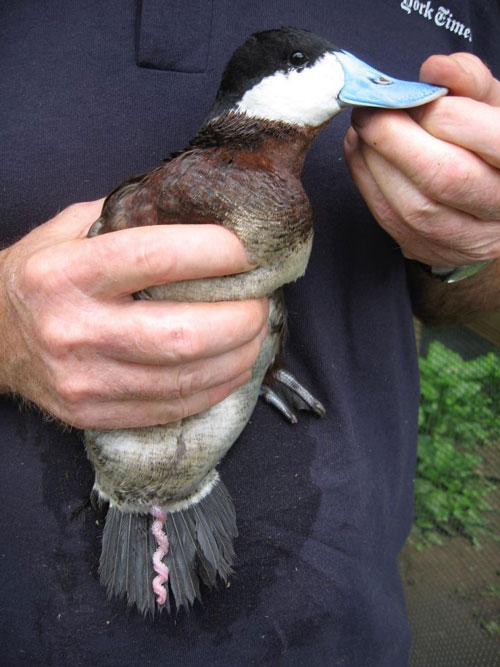



Social Environment Matters for Duck Penis Size
Most birds lack genitalia, but male ducks are known for their long, spiraling penises, which have evolved through an ongoing cat-and-mouse game with females.A new study from The Auk: Ornithological Advances looks at whether these impressive organs are affected by the social environment--that is, whether male ducks that face more competition grow bigger penises. While this appears to be true for some species, in others the relationship between social environment and penis growth is more complex.

Patricia Brennan of Mount Holyoke College and her colleagues tested their hypothesis in two species: Ruddy Ducks, which are very promiscuous, do not form pair bonds, and have relatively long penises, and Lesser Scaup, which form seasonal pair bonds and have relatively short penises. Keeping captive ducks in either pairs or groups during the breeding season over two years, they found that Lesser Scaup had longer penises on average when housed in groups with other males, as predicted.
For Ruddy Ducks, the effects were more complicated--many males failed to reach sexual maturity until the second year of the experiment, and when they did, the smaller Ruddy Duck males housed in groups grew their penises faster than males housed in pairs, but grew out of sync with each other and stayed in reproductive condition for only short periods of time.
Small Ruddy Ducks males faced with intense competition may strategically offset their development from each other to reduce the costs of male-male aggression and make the best of a bad situation. Additionally, since Ruddy Ducks already have relatively long penises on average compared to other waterfowl species, their ability to grow even larger based on social cues may be limited. In any case, the study shows that the level of competition that individual male ducks experience can have a big effect on their genitals.
The biggest challenge during the study, says Ms Brennan, wasn't measuring the ducks--it was simply keeping them housed and fed.
"Keeping ducks in captivity is expensive," says Ms Brennan. "We were lucky to partner with the Livingstone Ripley Waterfowl Conservancy in Litchfield, Connecticut, where their expert personnel kept the ducks healthy and in beautiful, naturalistic enclosures year-round."
"This is an excellent experimental study of penis morphology, looking at the effects of social environment on penis size in two duck species that have different mating systems," according to Queen's University's Bob Montgomerie, an expert on reproductive strategies who was not involved in the study.
"The question now is whether the observed increase in penis size in Lesser Scaup under the threat of sperm competition actually gives males a competitive advantage. Like all good studies, this one will undoubtedly stimulate more research, as it provides both methodologies and a clear focus on interesting questions."
September 2017








